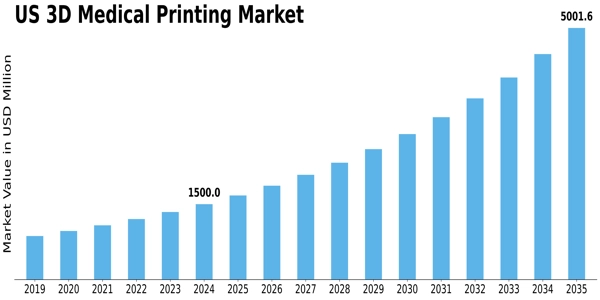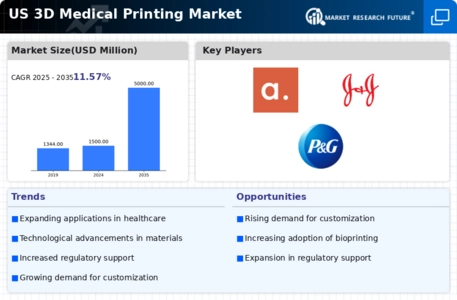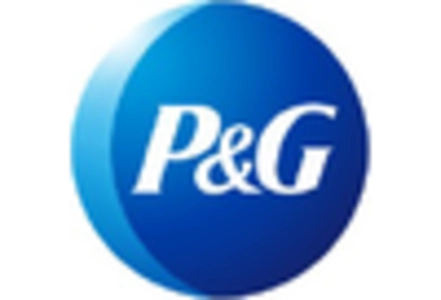-
EXECUTIVE SUMMARY
-
MARKET INTRODUCTION
-
2.1.
-
Definition
-
Scope of the Study
- Research Objective
- Limitations
-
2.2.2.
-
Assumptions
-
RESEARCH METHODOLOGY
-
Overview
-
Data Mining
-
Secondary Research
-
Primary Research
- Breakdown of Primary
-
3.4.1.
-
Primary Interviews and Information Gathering Process
-
Respondents
-
Forecasting Model
-
Market Size Estimation
- Top-Down Approach
-
3.6.1.
-
Bottom-Up Approach
-
Data Triangulation
-
Validation
-
MARKET DYNAMICS
-
Overview
-
Drivers
-
Restraints
-
Opportunities
-
MARKET FACTOR ANALYSIS
-
5.1.
-
Value Chain Analysis
-
Porter’s Five Forces Analysis
- Bargaining
- Bargaining Power of Buyers
- Threat of
- Threat of Substitutes
- Intensity of Rivalry
-
Power of Suppliers
-
New Entrants
-
COVID-19 Impact Analysis
- Market Impact Analysis
- Opportunity and Threat Analysis
-
5.3.2.
-
Regional Impact
-
US 3D MEDICAL
-
PRINTING MARKET, BY COMPONENT
-
Overview
-
Equipment
- 3D Bioprinters
-
6.2.1.
-
3D Printers
-
Materials
- Plastics
- Metals and Metal
- Biomaterials
- Ceramics
- Paper
- Other Materials
-
Alloys
-
6.3.6.
-
Wax
-
Services & Software
-
US 3D
-
MEDICAL PRINTING MARKET, BY APPLICATION
-
Overview
-
Surgical Guides
- Dental Guides
- Craniomaxillofacial Guides
- Orthopedic
- Spinal Guides
-
Guides
-
Surgical Instruments
- Surgical
- Scalpels
- Retractors
-
Fasteners
-
Standard Prosthetics
-
& Implants
-
Custom Prosthetics & Implants
- Orthopedic
- Dental Prosthetics & Implants
- Craniomaxillofacial
-
Implants
-
Implants
-
Tissue-engineered Products
- Bone & Cartilage Scaffolds
- Ligament & Tendon Scaffolds
-
Hearing Aids
-
Wearable
-
Medical Devices
-
Other Applications
-
US 3D MEDICAL PRINTING MARKET,
-
BY TECHNOLOGY
-
Overview
-
Laser Beam Melting
- Direct
- Selective Laser Sintering
- Selective
- LaserCUSING
-
Metal Laser Sintering
-
Laser Melting
-
Photopolymerization
- Stereolithography
- Two-photon Polymerization
- PolyJet 3D Printing
-
8.3.1.
-
Digital Light Processing
-
Droplet Deposition/Extrusion-based Technologies
- Fused Deposition Modeling
- Multiphase Jet Solidification
- Low-temperature Deposition Manufacturing
- Microextrusion Bioprinting
-
Electron Beam Melting
-
Three-dimensional Printing/Adhesion Bonding/Binder
-
Jetting
-
Other Technologies
-
US 3D MEDICAL PRINTING MARKET, BY END
-
USER
-
Overview
-
Hospitals & Surgical Centers
-
Dental
-
& Orthopedic Clinics
-
Academic Institutions & Research Laboratories
-
Pharma-Biotech & Medical Device Companies
-
Clinical Research
-
Organizations
-
COMPETITIVE LANDSCAPE
-
Overview
-
Competitive
-
Analysis
-
Market Share Analysis
-
Major Growth Strategy in the
-
US 3D Medical Printing Market,
-
Competitive Benchmarking
-
Leading
-
Players in Terms of Number of Developments in the US 3D Medical Printing Market,
-
Key developments and Growth Strategies
- New Product Launch/Service
- Merger & Acquisitions
- Joint Ventures
-
Deployment
-
Major Players Financial Matrix
- Sales & Operating Income,
- Major Players R&D Expenditure. 2022
-
COMPANY PROFILES
-
Stratasys Ltd. (Israel)
- Company Overview
- Financial
- Products Offered
- Key Developments
- Key Strategies
-
Overview
-
11.1.5.
-
SWOT Analysis
-
ENVISIONTEC (US)
- Financial Overview
- Products Offered
- Key Developments
- SWOT Analysis
- Key Strategies
-
11.2.1.
-
Company Overview
-
3D SYSTEMS, INC. (US)
- Company Overview
- Financial
- Products Offered
- Key Developments
- Key Strategies
-
Overview
-
11.3.5.
-
SWOT Analysis
-
EOS (US)
- Company
- Financial Overview
- Products Offered
- SWOT Analysis
- Key Strategies
- Company Overview
- Financial Overview
- Products Offered
- Key Developments
- SWOT Analysis
- Key Strategies
-
Overview
-
11.4.4.
-
Key Developments
-
11.5.
-
Renishaw pl (UK)
-
GE additive (US)
- Company Overview
- Financial Overview
- Products Offered
- Key Developments
- SWOT Analysis
- Key Strategies
-
Desktop Metal,Inc
- Company Overview
- Financial Overview
- Key Developments
- SWOT Analysis
-
(US)
-
11.7.3.
-
Products Offered
-
11.7.6.
-
Key Strategies
-
CELLINK (SWEDEN)
- Company Overview
- Products Offered
- Key Developments
- SWOT Analysis
- Key Strategies
-
11.8.2.
-
Financial Overview
-
FORMALABS (US)
- Company Overview
- Financial Overview
- Products
- Key Developments
- SWOT Analysis
- Key
-
Offered
-
Strategies
-
Materialise (Belgium)
- Company Overview
- Products Offered
- Key Developments
- SWOT Analysis
- Key Strategies
-
11.10.2.
-
Financial Overview
-
3T Additive Manufacturing
- Company Overview
- Financial Overview
- Key Developments
- SWOT Analysis
-
Ltd. (US)
-
11.11.3.
-
Products Offered
-
11.11.6.
-
Key Strategies
-
GENERAL ELECTRIC COMPANY (US)
- Company Overview
- Financial Overview
- Products Offered
- Key Developments
- SWOT Analysis
- Key Strategies
-
Carbon, Inc. (US)
- Company Overview
- Financial Overview
- Products
- Key Developments
- SWOT Analysis
-
Offered
-
11.13.6.
-
Key Strategies
-
Prodways Group (France)
- Company Overview
- Financial Overview
- Products Offered
- Key Developments
- SWOT Analysis
- Key Strategies
-
SLM SOLUTIONS
- Company Overview
- Financial Overview
- Key Developments
- SWOT Analysis
-
(GERMANY)
-
11.15.3.
-
Products Offered
-
11.15.6.
-
Key Strategies
-
FIT AG (Germany)
- Company Overview
- Products Offered
- Key Developments
- SWOT Analysis
- Key Strategies
-
11.16.2.
-
Financial Overview
-
Wacker Chemie
- Company Overview
- Financial Overview
- Products Offered
- Key Developments
- SWOT Analysis
- Key Strategies
-
AG (Germany)
-
Denstply Sirona (USA)
- Company
- Financial Overview
- Products Offered
- SWOT Analysis
- Key Strategies
- Company Overview
- Financial Overview
- Products Offered
- Key Developments
- SWOT Analysis
- Key Strategies
-
Overview
-
11.18.4.
-
Key Developments
-
11.19.
-
DWS Systems SRL(Italy)
-
ROLAND DG(JAPAN)
- Company Overview
- Financial Overview
- Products Offered
- Key Developments
- SWOT Analysis
- Key Strategies
-
HP, Inc (USA)
- Company Overview
- Financial Overview
- Products
- Key Developments
- SWOT Analysis
-
Offered
-
11.21.6.
-
Key Strategies
-
RegenHU (Switzerland)
- Company Overview
- Financial Overview
- Products Offered
- Key Developments
- SWOT Analysis
- Key Strategies
-
Fluicell (Sweden)
- Company Overview
- Financial Overview
- Products
- Key Developments
- SWOT Analysis
-
Offered
-
11.23.6.
-
Key Strategies
-
Proto Labs (US)
- Company Overview
- Products Offered
- Key Developments
- SWOT Analysis
- Key Strategies
-
11.24.2.
-
Financial Overview
-
GESIM (Germany)
- Company Overview
- Financial Overview
- Products
- Key Developments
- SWOT Analysis
-
Offered
-
11.25.6.
-
Key Strategies
-
Triastek (China)
- Company Overview
- Products Offered
- Key Developments
- SWOT Analysis
- Key Strategies
-
11.26.2.
-
Financial Overview
-
Inventia (Australia)
- Company Overview
- Financial Overview
- Products
- Key Developments
- SWOT Analysis
-
Offered
-
11.27.6.
-
Key Strategies
-
FabRx (UK)
- Company Overview
- Products Offered
- Key Developments
- SWOT Analysis
- Key Strategies
-
11.28.2.
-
Financial Overview
-
Apprecia Pharmaceuticals
- Company Overview
- Financial Overview
- Key Developments
- SWOT Analysis
-
(US)
-
11.29.3.
-
Products Offered
-
11.29.6.
-
Key Strategies
-
APPENDIX
-
References
-
Related Reports
-
-
LIST OF TABLES
-
US 3D MEDICAL PRINTING MARKET, SYNOPSIS,
-
US 3D MEDICAL PRINTING MARKET, ESTIMATES & FORECAST,
-
US 3D MEDICAL PRINTING MARKET, BY COMPONENT,
-
US 3D MEDICAL PRINTING MARKET, BY APPLICATION,
-
US 3D MEDICAL PRINTING MARKET, BY TECHNOLOGY,
-
US 3D MEDICAL PRINTING MARKET, BY END USER,
-
LIST OF FIGURES
-
RESEARCH PROCESS
-
MARKET STRUCTURE FOR THE US 3D MEDICAL PRINTING MARKET
-
FIGURE 3
-
MARKET DYNAMICS FOR THE US 3D MEDICAL PRINTING MARKET
-
US 3D MEDICAL
-
PRINTING MARKET, SHARE (%), BY COMPONENT, 2021
-
US 3D MEDICAL PRINTING
-
MARKET, SHARE (%), BY APPLICATION, 2021
-
US 3D MEDICAL PRINTING MARKET,
-
SHARE (%), BY TECHNOLOGY, 2021
-
US 3D MEDICAL PRINTING MARKET, SHARE
-
(%), BY END USER, 2021
-
US 3D MEDICAL PRINTING MARKET, SHARE (%),
-
BY REGION, 2021
-
US 3D MEDICAL PRINTING MARKET: COMPANY SHARE ANALYSIS,
-
STRATASYS LTD. (ISRAEL): FINANCIAL OVERVIEW SNAPSHOT
-
STRATASYS LTD. (ISRAEL): SWOT ANALYSIS
-
ENVISIONTEC (US):
-
FINANCIAL OVERVIEW SNAPSHOT
-
ENVISIONTEC (US): SWOT ANALYSIS
-
FIGURE
-
3D SYSTEMS, INC. (US): FINANCIAL OVERVIEW SNAPSHOT
-
3D SYSTEMS,
-
INC. (US): SWOT ANALYSIS
-
EOS (US): FINANCIAL OVERVIEW SNAPSHOT
-
EOS (US): SWOT ANALYSIS
-
RENISHAW PL (UK): FINANCIAL OVERVIEW
-
SNAPSHOT
-
RENISHAW PL (UK): SWOT ANALYSIS
-
GE ADDITIVE
-
(US): FINANCIAL OVERVIEW SNAPSHOT
-
GE ADDITIVE (US): SWOT ANALYSIS
-
DESKTOP METAL,INC (US): FINANCIAL OVERVIEW SNAPSHOT
-
FIGURE
-
DESKTOP METAL,INC (US): SWOT ANALYSIS
-
CELLINK (SWEDEN): FINANCIAL
-
OVERVIEW SNAPSHOT
-
CELLINK (SWEDEN): SWOT ANALYSIS
-
FIGURE 26
-
FORMALABS (US): FINANCIAL OVERVIEW SNAPSHOT
-
FORMALABS (US): SWOT
-
ANALYSIS
-
MATERIALISE (BELGIUM),: FINANCIAL OVERVIEW SNAPSHOT
-
FIGURE
-
MATERIALISE (BELGIUM),: SWOT ANALYSIS
-
3T ADDITIVE MANUFACTURING
-
LTD. (US): FINANCIAL OVERVIEW SNAPSHOT
-
3T ADDITIVE MANUFACTURING
-
LTD. (US): SWOT ANALYSIS
-
GENERAL ELECTRIC COMPANY (US): FINANCIAL
-
OVERVIEW SNAPSHOT
-
GENERAL ELECTRIC COMPANY (US): SWOT ANALYSIS
-
CARBON, INC. (US): FINANCIAL OVERVIEW SNAPSHOT
-
CARBON,
-
INC. (US): SWOT ANALYSIS
-
PRODWAYS GROUP (FRANCE): FINANCIAL OVERVIEW
-
SNAPSHOT
-
PRODWAYS GROUP (FRANCE): SWOT ANALYSIS
-
SLM
-
SOLUTIONS (GERMANY): FINANCIAL OVERVIEW SNAPSHOT
-
SLM SOLUTIONS (GERMANY):
-
SWOT ANALYSIS
-
FIT AG (GERMANY): FINANCIAL OVERVIEW SNAPSHOT
-
FIGURE
-
FIT AG (GERMANY): SWOT ANALYSIS
-
WACKER CHEMIE AG (GERMANY): FINANCIAL
-
OVERVIEW SNAPSHOT
-
WACKER CHEMIE AG (GERMANY): SWOT ANALYSIS
-
FIGURE
-
DENSTPLY SIRONA (USA): FINANCIAL OVERVIEW SNAPSHOT
-
DENSTPLY SIRONA
-
(USA): SWOT ANALYSIS
-
DWS SYSTEMS SRL(ITALY): FINANCIAL OVERVIEW SNAPSHOT
-
DWS SYSTEMS SRL(ITALY): SWOT ANALYSIS
-
ROLAND DG(JAPAN):
-
FINANCIAL OVERVIEW SNAPSHOT
-
ROLAND DG(JAPAN): SWOT ANALYSIS
-
FIGURE
-
HP, INC (USA): FINANCIAL OVERVIEW SNAPSHOT
-
HP, INC (USA): SWOT
-
ANALYSIS
-
REGENHU (SWITZERLAND): FINANCIAL OVERVIEW SNAPSHOT
-
FIGURE
-
REGENHU (SWITZERLAND): SWOT ANALYSIS
-
FLUICELI (SWEDEN): FINANCIAL
-
OVERVIEW SNAPSHOT
-
FLUICELI (SWEDEN): SWOT ANALYSIS
-
FIGURE 56
-
PROTO LABS (US): FINANCIAL OVERVIEW SNAPSHOT
-
PROTO LABS (US): SWOT
-
ANALYSIS
-
GESIM (GERMANY): FINANCIAL OVERVIEW SNAPSHOT
-
FIGURE
-
GESIM (GERMANY): SWOT ANALYSIS
-
TRIASTEK (CHINA): FINANCIAL OVERVIEW
-
SNAPSHOT
-
TRIASTEK (CHINA): SWOT ANALYSIS
-
INVENTIA
-
(AUSTRALIA): FINANCIAL OVERVIEW SNAPSHOT
-
INVENTIA (AUSTRALIA): SWOT
-
ANALYSIS
-
FABRX (UK): FINANCIAL OVERVIEW SNAPSHOT
-
FABRX
-
(UK): SWOT ANALYSIS
-
APPRECIA PHARMACEUTICALS (US): FINANCIAL OVERVIEW
-
SNAPSHOT
-
APPRECIA PHARMACEUTICALS (US): SWOT ANALYSIS







Leave a Comment